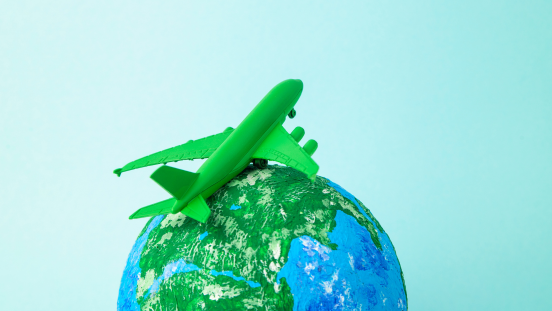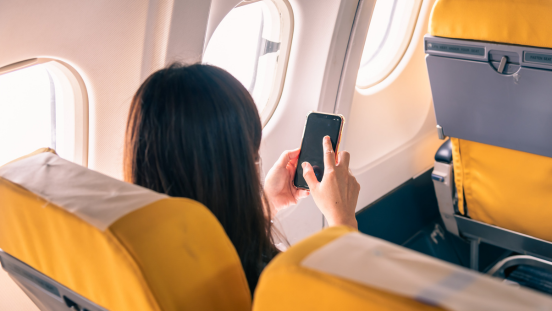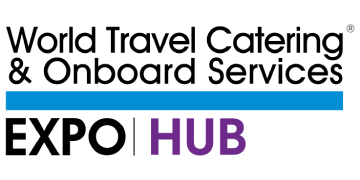
The world of air travel is undergoing rapid transformation. As technology develops and consumer preferences continue to evolve, the onboard experience needs to become increasingly sophisticated in line with this shift.
Passengers, in particular, are now demanding more from their travel. They’re increasingly seeking comfort, convenience, and a seamless journey, which aligns with their specific needs. To stay competitive, airlines are adapting to these evolving expectations and redefining their in-flight offering.
The worlds of travel and hospitality are converging to create a sophisticated onboard passenger experience. But what is driving the changes? What direction is the industry moving in? And how can airlines look to adapt their offering to meet the evolving needs of today’s passengers?
Evolving passenger experience / expectations
It’s been an unprecedented few years for the airline industry. According to Statistica1, the number of flights taking off globally has increased steadily since the early 2000s, reaching 38.9 million in 2019. However, due to the coronavirus pandemic, the number of flights dropped to 18.3 million in 2020. In the years that followed, the number of flights has grown significantly, and was forecasted to reach 38.7 million in 2024.
Despite this growth, it hasn’t been an entirely smooth recovery for airlines. Though travellers have now returned to the skies, many passengers now have a variety of different expectations for their journeys–both in terms of their onboard experience and what they expect from an airline when it comes to communication, reputation and corporate responsibility.
While many are seeking a more holistic and personalised travel experience, which encompasses everything from pre-flight communication and seamless check-in processes to comfortable and well-equipped cabins, and even in-flight entertainment and service options.
Sustainable flying

With a wealth of information readily available online and being shared via social media platforms, consumers are more educated than ever before.
Survey data from McKinsey and Co.2 suggests that most passengers now understand that aviation has a significant impact on the environment. In fact, its research demonstrates that emissions are now the top concern of respondents in 11 of the 13 countries polled–increasing from just four in a 2019 survey. With more than half of respondents reporting that they’re “really worried” about climate change, and that aviation should become carbon neutral in the future, sustainability is no longer a choice but an imperative. As such an important passenger priority, sustainable products and practices within the cabin should now be considered an essential element of the passenger experience and potentially a key differentiator for airlines.
With sustainability now an integral part of business strategies for airlines across the globe, it’s crucial that they follow through to avoid any suggestion of greenwashing. Given that so much of the aviation industry goes unseen, implementing sustainable practices in the cabin is an important way of demonstrating initiatives to passengers. This is both in the form of effective waste management practices, as well as making ethical and sustainable decisions when it comes to food, beverage and amenity choices onboard.
Though pre-order systems are certainly nothing new or revolutionary, they are now helping to drive forward sustainability initiatives. For instance, data from IATA revealed that untouched meals account for 18% of all onboard waste3. Providing the option to pre-order food, beverages and amenities can drastically reduce waste onboard, all the while, providing passengers with a streamlined and convenient service.
The integration of newer technologies such as artificial intelligence (AI) can also help reduce cabin waste and reach sustainability goals. For example, KLM Royal Dutch Airlines4 has reported producing up to 63% less food waste using AI. By more accurately predicting how many passengers will actually board a flight, this allows the airline to predict the exact number of meals required.
Moving forward, we can expect to see more airlines harnessing both new and existing technologies to meet evolving customer needs and demands.
Personalisation and passenger loyalty
Another of the most impactful trends currently developing in the travel industry, is the concept of a personalised passenger experience. According to McKinsey and Co.5, 78% of consumers are more likely to make repeat purchases from companies that personalise their communications, products or services. The research suggests that personalisation can not only drive repeat engagement but drive customer loyalty over time.
Paul Bilham, Chief Revenue Officer at Data Clarity explains, “For airlines, Net Promoter Score (NPS) and passenger satisfaction are crucial indicators of ongoing passenger loyalty–price, reliability and quality of service remain key in an industry which is about transporting people. However, to differentiate and retain passengers, as well as attract new customers, airlines need to add new services and products to their offering–whether that is free high-speed Wi-Fi or differentiating through unique onboard retail products which are relevant to the airline’s brand or destinations it serves.”
Andy Palacios, Vice President of Growth and Strategic Partnerships at LiFE in the Air adds, “Personalisation in the passenger experience is becoming increasingly important. In our daily interactions with companies, whether at a local grocery store or with a clothing brand, we experience a high level of personalisation, setting a standard for all our consumer interactions. Travel is inherently a personal journey, involving numerous touchpoints from planning and booking to boarding and the onboard experience. Airlines have a unique opportunity to enhance this journey by creating memorable and personalised experiences.”
In a digital age, many consumers are chasing a personalised experience in order to feel valued and understood as individuals by the brands they engage with. But how can brands engage with customers they’ve never personally met?
Palacios goes on to say, “From tailoring communications and offers during the pre-trip phase to customising in-flight services like meals and entertainment, airlines can significantly improve customer satisfaction. Personal touches, such as recognising frequent flyers or addressing passengers by name, can make passengers feel valued and appreciated.”
Taking advantage of passenger data

Unsurprisingly, data is the key to unlocking this personalised experience and the rewards that come with it. Fortunately, airlines have a huge amount of passenger data at their disposal, through which, they can better understand their clientele, and subsequently provide a tailored, bespoke experience.
Bilham says, “Airlines have a wealth of data, about their passengers, at their fingertips which offers the opportunity to deliver personalisation.” However, hehighlights that, “Currently, data silos and the multitude of different departments and stakeholders involved from an airline perspective can make change challenging. Passenger expectations will only continue to increase, both in terms of experience of selecting options such as onboard food prior to flying, and during travel where connectivity and comfort are becoming key.”
Kai Kosicki, WTCE’s 2025 Technology Ambassador, Consultant for the Hayward Partnership and Founder of ExpAir, adds to the discussion, explaining that personalisation is another key element in helping airlines to drive new revenues and take advantage of their new and existing tools and technologies. He says, “Personalisation is key. However, you know that airlines work in mass transport, mass traffic and high standardisation. So how do you produce personalised results in a highly standardised environment? Through intelligent technologies and smart use of data, airlines will be able to deliver a personalised product within these standards.”
How are airlines transforming?
Euromonitor International suggests that incorporating AI tools into an airline’s loyalty programmes can support seamless operations and increase programme appeal. With data from its Voice of the Consumer: Digital Survey6 finding that 87% of Generation Z and millennials acknowledge the benefits of shopping with embedded Generative AI tools, Euromonitor highlights that many carriers are shifting their approach in line with this.
But how are airlines implementing these tools and technologies in practice? For example, earlier this year, JetBlue released Blueprint7, its personalised inflight entertainment experience, which providers new seatback touchscreen features that mimic what customers are used to experiencing with their favourite streaming platforms at home. This adds to JetBlue’s existing personalised passenger features, including in-seat ordering, flight connectivity and loyalty programmes.
Similarly, Riyadh Air and FLYR8 also recently announced a partnership to deliver ‘the world’s first digitally-native airline’. But what exactly is meant by this? FLYR’s technology will enable Riyadh Air to move forward in airline retailing, introducing key capabilities such as shopping cart-like experiences, where customers can book and change plans seamlessly, accessing everything they need for their trip in one location.
Meanwhile, Qatar Airways’ digital transformation has seen it provide 15,000 cabin crew members with iPhones to deliver a more personalised experience on board. The in-house application enables crew members to view passengers’ profiles–including Privilege Club loyalty members and Oneworld members–as well as all special service requests and preferences.
These are great examples of how airlines are transforming their digital and physical infrastructure for the ease of both passengers and staff. As these technologies become more commonplace, we can expect to see an increasing number of airlines adopting these tools and practices.
An evolving passenger base
Keeping on top of customer needs and preferences is an ongoing responsibility for airlines, and this is largely due to an evolving passenger demographic.
According to Official Airline Guide9 (OAG), “airline customer centricity” has previously been aimed at Generation X and Baby Boomers, as they have been the key travel spenders over the last few decades. However, as of 2024, Millennials (born 1981-1996) have overtaken these older generations to become the demographic contributing to more than half of all air travel spending.
Meanwhile, Generation Z (born 1997-2012), the youngest group of paying travellers, is also beginning to have an impact on the industry. OAG suggests that by 2035, these two groups will account for over 80% of all airline-related travel expenditures. But what impact might this have on airlines?
Connecting with passengers
To connect with key audiences, airlines need to explore their needs and preferences. For example, research10 suggests that Millennials are seeking out an authentic experience in their travel ventures. Notably, 86% want to connect with local culture, food, and knowledge when in a new destination, while more than half of them consider free Wi-Fi to be the most sought-after amenity.
But how can airlines use this kind of data to ensure they are meeting the needs of their passengers? For example, it’s clear that Millennials are looking to receive authentic experiences via seamless technology integrated onboard. Whether it’s offering pre-order services to allow passengers to conveniently customise their meals, providing bespoke in-flight entertainment, or offers for post-flight activities, it’s important for airlines to acknowledge the preferences of their key customer demographics.
Bringing onboard solutions to life
While this approach is stellar in theory, how are airlines really using these strategies to transform their passenger experience? By working closely with prominent airlines, LiFE in the Air has successfully implemented solutions to address their specific challenges.
Palacios explains “We partnered with a leading airline to successfully address its challenges related to in-flight sales and passenger satisfaction. By implementing a custom Order-from-Seat solution, we could work with the airline to embrace innovation, leverage technology, and boost its revenue while enhancing the overall travel experience for its passengers.” From a results perspective, the airline partner experienced a 30% increase in onboard sales following the implementation of Order-from-Seat solution. The solution also received overwhelmingly positive feedback from passengers, leading to higher levels of traveller satisfaction.
Considering the future onboard experience
As we look to the future, the sky seems to be the limit when it comes to maximising the passenger experience. But how can we expect to see the onboard experience shift with new technologies and exciting innovations?
Palacios suggests, “Over time, advancements in Artificial Intelligence (AI) and Machine Learning (ML) will become even more sophisticated, creating new opportunities that have yet to be considered. These technologies will enable more profound insights into passenger behavior and preferences, allowing airlines to anticipate and meet passenger needs with unprecedented accuracy, creating a truly tailored travel experience.”
Despite its potential, the success of AI as a business tool hinges on the user trust, acceptance and training.
Leandro Röschli, Founder at LimeFlight, highlights the potential of AI, noting that one of the key opportunities lies in building user trust. He says, “It is often challenging for users to grasp how decisions are made, so demonstrating consistent accuracy and reliability in AI outputs is essential.”
He adds, “Clear and effective communication regarding the capabilities and limitations of AI systems is crucial for managing expectations and building trust. When executed well, people are often amazed by the possibilities that AI can create.”
It’s evident that advances in technology will be paramount in helping the onboard hospitality sector reach new heights. However, success will be found in the implementation and the appropriate use of these technologies, ensuring the end-user stays front of mind at all times.
WTCE: an unrivalled resource

To create the onboard experience of tomorrow, airlines should look to World Travel Catering & Onboard Services Expo (WTCE) as the unrivalled global platform for identifying the most exciting onboard trends, products and services. Bringing together food and beverage, amenities, and technology suppliers, the exhibition hosts a range of features that provide key insights into the current and upcoming trends and items sweeping the industry.
Moving forward, airlines will face increasing pressure to deliver exceptional passenger experiences. To remain competitive, airlines and other travel operators must continuously innovate and adapt. WTCE 2025 offers a valuable platform to explore cutting-edge technologies, innovative products, and industry best practices. Attendees will gain the insights needed to reinvent their services and meet the evolving needs of today’s discerning travellers.
Acting as an educational resource, WTCE’s Taste of Travel Theatre will offer a dedicated space for industry professionals to consider the most prominent onboard developments. With a programme overflowing with insightful seminars, cooking demos and tasting opportunities, Taste of Travel Theatre provides visitors with industry knowledge from a huge range of influential thought leaders and experts throughout the event.
To learn more about key industry developments or for details of WTCE 2025, please visit https://www.worldtravelcateringexpo.com/en-gb.html.
- https://www.statista.com/statistics/564769/airline-industry-number-of-flights/#:~:text=The%20number%20of%20flights%20performed ↩︎
- https://www.mckinsey.com/industries/travel-logistics-and-infrastructure/our-insights/opportunities-for-industry-leaders-as-new-travelers-take-to-the-skies ↩︎
- https://www.businesstraveller.com/business-travel/2024/07/06/iata-untouched-meals-account-for-18-per-cent-of-inflight-waste/ ↩︎
- https://news.klm.com/klm-deploys-artificial-intelligence-to-combat-food-waste/ ↩︎
- https://www.mckinsey.com/capabilities/growth-marketing-and-sales/our-insights/the-value-of-getting-personalization-right-or-wrong-is-multiplying ↩︎
- https://www.euromonitor.com/article/modernising-loyalty-how-airlines-are-capturing-millennials-and-gen-z-travellersnew-page#:~:text=Incorporating%20AI%20tools%20into%20airline’s,with%20their%20tech%2Dsavvy%20members ↩︎
- https://news.jetblue.com/latest-news/press-release-details/2024/JetBlue-Elevates-Seamless-Living-in-the-Sky-with-Blueprint-by-JetBlue-A-Personalized-Inflight-Experience/default.aspx ↩︎
- https://flyr.com/resource-hub/flyr-and-riyadh-air-partner-to-deliver-the-worlds-first-digitally-native-airline-utilizing-offer-and-order-technology/ ↩︎
- https://www.oag.com/blog/generational-shifts-airline-industry ↩︎
- https://www.littlehotelier.com/blog/running-your-property/changing-trends-millennial-travelers-target/#:~:text=Millennials%20are%20quite%20spontaneous%20and,most%20sought%20after%20hotel%20amenity ↩︎
Join us at World Travel Catering & Onboard Services Expo
Join the industry’s main marketplace for a world of inspiration to enhance the onboard experience.
Join us from 14-16 April 2026 at Hamburg Messe.
